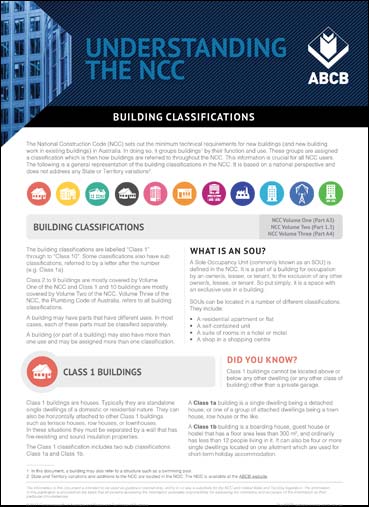There is no doubt that the construction industry is under more scrutiny than ever before due to the increasing pressure on certifiers who have seen ridiculously high increases in their insurance. As a result of the pressure on certifiers, they will put more pressure on builders to ensure they are complying with the various standards and of course the builders will be expecting more from the fabricators.
The National Construction Code 2019 has thrown up a few hiccups for our industry in relation to energy efficiency, particularly in WA and there has also been slight changes to the Earthquake Provisions for all Class 2-9 Buildings irrespective of where the building is located (see below).
Are you aware of these changes? It has never been more important for fabricators to understand your obligations as you can be guaranteed certifiers will be pressuring builders and they will then pressure for you to provide the necessary compliance documentation.
Understanding the NCC
If you’re a regular user of the NCC then chances are you probably have to comply with NCC referenced documents.
But how do you ensure you are using the correct edition? Do you understand how to apply secondary references? There might be more to it than you think!
With over 100 referenced documents called up in the NCC, it’s likely you’ll need to comply with at least one referenced document in some part of your work.
This link will provide more information on Understanding NCC Referenced Documents which I encourage you all to visit: the ABCB website.
Earthquake Provisions for Class 2-9 buildings
This week a fabricator was contacted by the builder to ask if they had designed the College they were working on in accordance with the new Earthquake Provisions as outlined in the NCC. Did you know this was a new requirement for all Class 2-9 Buildings and do you know what is required of you, the fabricator?
NCC Volume One contains a Performance Requirement (BP1.1) that requires Class 2 to 9 buildings to perform adequately under all reasonably expected design actions, including earthquake actions. The corresponding Deemed-to-Satisfy (DTS) Provision for earthquake actions is B1.2, which references AS 1170.4 Structural design actions – Earthquake actions in Australia.
Section 3 of AS 1170.4 applies a hazard design factor to all regions of Australia. This requires earthquake loads to be considered in the design of any building irrespective of where it is located. For further information on this issue please refer to this ABCB article.
Given the importance of compliance the ever changing requirements of our industry, I would encourage fabricators and suppliers to register with the ABCB. When you register you can choose what type of information you would like to be kept updated on such as Structural Safety, Fire Safety, Building Services or Energy Efficiency.
It is up to the whole supply chain to keep their finger on the pulse and to raise issues that they may see as important for the whole supply chain to address. This way we can ensure nothing slips through the radar without the industry being involved.
To register for the ABCB Resources and latest news or updates please visit the ABCB.
If you have any concerns on issues that you need assistance with please give me a call on 0418 226 242 or email me at kersten@ftma.com.au I don’t have a technical bone in my body but I do know now how to get the right answers and ensure you fabricators can focus on their work whilst we find the solutions for you.
Kersten Gentle

